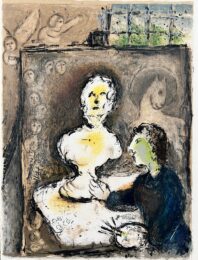

Jean-Émile Laboureur (1877-1943) was a French printmaker and artist known for his innovative approach to printmaking techniques and his mastery of various mediums. Laboureur’s prints are characterized by their intricate details, precise line work, and a sophisticated use of composition.
Here are some key characteristics of Jean-Émile Laboureur’s prints:
Techniques
Laboureur was highly skilled in various printmaking techniques, including etching, engraving, woodcuts, and lithography. He often combined multiple techniques in a single print, pushing the boundaries of traditional printmaking and experimenting with innovative approaches.
Intricate Line Work
Laboureur’s prints display a remarkable attention to detail. He employed fine, delicate lines to create texture, depth, and definition within his compositions. The precision and intricacy of his line work give his prints a refined and meticulous quality.
Composition
Laboureur had a strong sense of composition and design. His prints feature well-balanced arrangements of forms, with careful consideration given to negative space and the placement of figures or objects within the composition. Laboureur’s compositions often exhibit a harmonious balance between detailed elements and open areas, creating a sense of visual harmony.
Depiction of Everyday Life
Laboureur was interested in capturing scenes from everyday life. He often depicted urban landscapes, street scenes, portraits, and genre scenes. His prints provide glimpses into the lives of ordinary people, showcasing their activities, interactions, and the environment they inhabited.
Social Commentary
Laboureur’s prints often carried social and political undertones. He used his art to comment on the social issues of his time, including class disparities, industrialization, and the impact of modernity on society. Laboureur’s prints serve as a reflection of the social and cultural context in which he lived.
Experimental Approaches
Laboureur was known for his experimentation with printmaking techniques. He pushed the boundaries of traditional methods, exploring new ways to manipulate and transform the surfaces of his prints. Laboureur’s experimental techniques included scratching, scraping, and incising the plate to create unique textures and effects.
Influences from Japanese Art
Laboureur was inspired by Japanese woodblock prints and incorporated elements of their aesthetic into his own work. He admired the simplicity, elegance, and composition found in Japanese prints and incorporated similar principles into his own compositions.
Range of Subjects
Laboureur’s prints cover a wide range of subjects, including landscapes, urban scenes, portraits, still lifes, and allegorical themes. He explored both the mundane and the symbolic, capturing the beauty and essence of his subjects through his artistic interpretation.
Print Series
Laboureur created several print series throughout his career. One notable series is “Les Métiers” (The Trades), which depicts various professions and trades through detailed and expressive prints. This series exemplifies Laboureur’s ability to capture the spirit and character of different occupations.
Collaboration
Laboureur collaborated with prominent writers and poets, creating illustrations for their literary works. His prints often accompanied texts, merging the visual and literary arts into a cohesive and engaging experience.